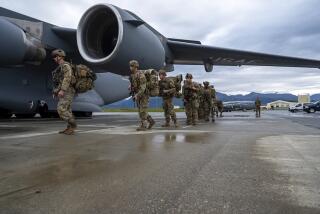Marines Take Long, Hard Road in Alaska
- Share via
ANNETTE ISLAND, Alaska — A visitor looks at this rocky, chilly, mountainous, densely forested terrain and thinks: Alaska, America’s last frontier.
The Marine Corps looks at the same rugged landscape and thinks: the Korean Peninsula, a potential international hot spot.
With the topographical similarities between the two locales in mind, Marines from Camp Pendleton are taking a lead role in a multi-service project to build a 14.5-mile road to connect the impoverished Indian community of Metlakatla to a sheltered bay that someday will offer ferry service to Ketchikan on the mainland.
The two-lane road will end the Indians’ isolation and possibly be a ticket to economic survival. For the Marine Corps, Operation Alaskan Road is a priceless opportunity to get realistic training in building a combat-ready road through one of the most hostile, forbidding natural environments on Earth, such as the one they might face in Korea.
“This is definitely the kind of training you could never get at Camp Pendleton,” said Capt. Robert Kurowski, a company commander with the 7th Engineer Support Battalion from Camp Pendleton. The battalion has deployed 125 Marines to the island for the summer.
Bulldozers are practically useless here. Excavating machines sink in the mire. Chain saws rust and become dull. Marines have had to learn how to rappel down sheer rock mountainsides to hack down trees.
The soil of Annette Island is tangled and soupy, the rock beneath is granite. The soil has to be scraped and piled, and the chopped-down trees must be burned. The rock has to be blasted and then crushed.
To get to the work site, Marines must endure a daily two-hour round trip from their base camp, over a buttocks-numbing, spine-crunching logging road. The weather can shift with little warning, bringing torrents of cold, driven rain, a far cry from the sunny summer climate at their home base in northern San Diego County.
Progress on the road is measured virtually in yards. The goal for this summer was for the Marines and the Army troops working on a different stretch to complete 1.8 miles. Now it looks like they will be pleased to finish 1.2 miles.
Battalion commander Lt. Col. James Harbison, who has built roads throughout the world for the Marine Corps, calls the project “by far the greatest challenge I’ve ever seen.”
For half a century the Tsimpshian Indians, who own Annette Island, had pleaded for help in establishing an all-weather link to the outside world. But the state and federal governments responded that building such a road was too difficult and too expensive, particularly because only about 1,600 people live on the island.
Just when the idea of a road for Annette Island seemed dead, the project was included two years ago in Innovative Readiness Training.
The new armed services program provides public works-style projects for civilian communities and training exercises for active-duty and reserve personnel. Priority is given to projects that offer the kind of topographic, logistic and engineering challenges that the military might someday be expected to overcome. Under those criteria, Annette Island zoomed to the top of the list.
In an era when budgets for military training are being squeezed, Innovative Readiness Training, begun by Congress in 1992, is seen as a win-win. The military gets training and civilian communities get roads, athletic fields, boat landings and other infrastructure amenities.
The Tsimpshian Indians’ history at Annette Island dates to 1887, when the tribe was brought here from British Columbia by its Christian spiritual leader, a lay minister from the Church of England named William Duncan.
During World War II, thousands of U.S. troops were stationed at Metlakatla, awaiting a Japanese invasion that never occurred. Now all that is left of the military presence is an abandoned airstrip on this green-clad island just 15 miles from the Alaskan-Canadian border.
The tribe’s economy is dependent on the salmon and timber industries, both of which have been devastated by competition and the downturn in the Asian economy. The sawmill and fish cannery are closed; unemployment is 80%.
Tribal leaders hope that the road will help Metlakatla attract some of the 500,000 tourists from the cruise ships that stop in Ketchikan each summer. One long-range idea among some tribal leaders is for the tribe to open a casino, although that would require state approval.
More immediate, the road would make it easier for tribal members to go to Ketchikan for college courses, medical needs and shopping, and help in the export of tribal handicrafts and frozen salmon.
Program’s Most Difficult Project
As a more practical matter, the kind of construction projects that the military once undertook as training exercises in South America, Central America and Africa are now being done in this country instead. If that helps increase political support for the Department of Defense budget, the military is not going to object.
The $20-million road project on Annette Island is the most expensive, most complex, most difficult project attempted under Innovative Readiness Training.
Much of the difficulty comes from the presence of muskeg, a devilishly boggy, marshy mess containing layers of moss and other decaying vegetation. Muskeg is unique to southwest Alaska and is one reason why so few roads are built in the region.
“If you’re thinking you’re coming up here with regular military equipment and building a road, forget it,” said Navy Capt. Douglas Barber, the lead engineer on Operation Alaskan Road. “It’s just plain difficult terrain.”
Barber, a reservist, is a civil engineer from Alaska with extensive experience building roads throughout the state. Even by Alaskan standards, he said, this project is daunting.
Initial surveys suggested that the muskeg was 1 to 2 feet thick along the route. The Marine Corps has found instead that in some spots, the muskeg is up to 8 feet thick; giant earthmoving equipment has sunk virtually out of sight.
Asked what lesson her troops have learned from battling muskeg, Lt. Danielle Minor said simply, “Patience.”
The Marines are also learning a lesson in what the military calls “jointness,” that is, working with other military services. With all branches of the military being reduced in size, the need to work cooperatively has never been greater, particularly in a combat situation where there would be little time to waste on interservice rivalry or misunderstanding.
Each military service has its own culture that leads it to see the world in a unique way. An old joke holds that if asked to “secure” a building, the Navy would paint it, the Army would post a sentry, the Air Force would sign a five-year lease, and the Marine Corps would burn it down.
Roads Play Key Role in Strategy
The lessons of Annette Island--grit, personal responsibility, unit cohesion under harsh circumstances--are meant to help the Marines wherever their next construction assignment might be.
But because of the similarity in the terrain, the lessons will be particularly applicable if the Marines in the battalion--or their successors--are ever ordered to Korea, according to Kurowski and Harbison.
If geopolitical push ever comes to military shove between North Korea and South Korea, it could fall to the engineering battalions of the Marine Corps to ensure that the region’s roads are kept clear and, if need be, that roads are hurriedly built so that U.S. and South Korean combat troops can move quickly to engage the enemy.
Roads are particularly important to the Marine Corps doctrine of “maneuver warfare” that calls for fast and high-powered assaults at multiple sites to persuade an adversary that surrendering would be a prudent idea.
The mountainous regions of Korea have few roads, meaning that the transportation is “channelized” and thus easily blocked. Devising routes around, under or through such roadblocks is the job of the engineering battalions.
“We move the force,” Harbison said.
Operation Alaskan Road is to take five summers, with work halting when the weather gets heavy. Last summer was the first, with troops building housing and other structures. Once the gravel road is completed, the Bureau of Indian Affairs will spend $15 million to have it paved.
The state of Alaska is planning to begin daily ferry service to Hemlock Bay. Metlakatla is only 15 miles offshore from Ketchikan, but the island is often unreachable by boat or seaplane during the long, unrelenting Alaskan winter, when winds can exceed 100 mph and the island gets more than 100 inches of rain.
“The road is our future,” said tribal council member Terry Booth. “We’ve waited a long time.”
More to Read
Sign up for Essential California
The most important California stories and recommendations in your inbox every morning.
You may occasionally receive promotional content from the Los Angeles Times.













